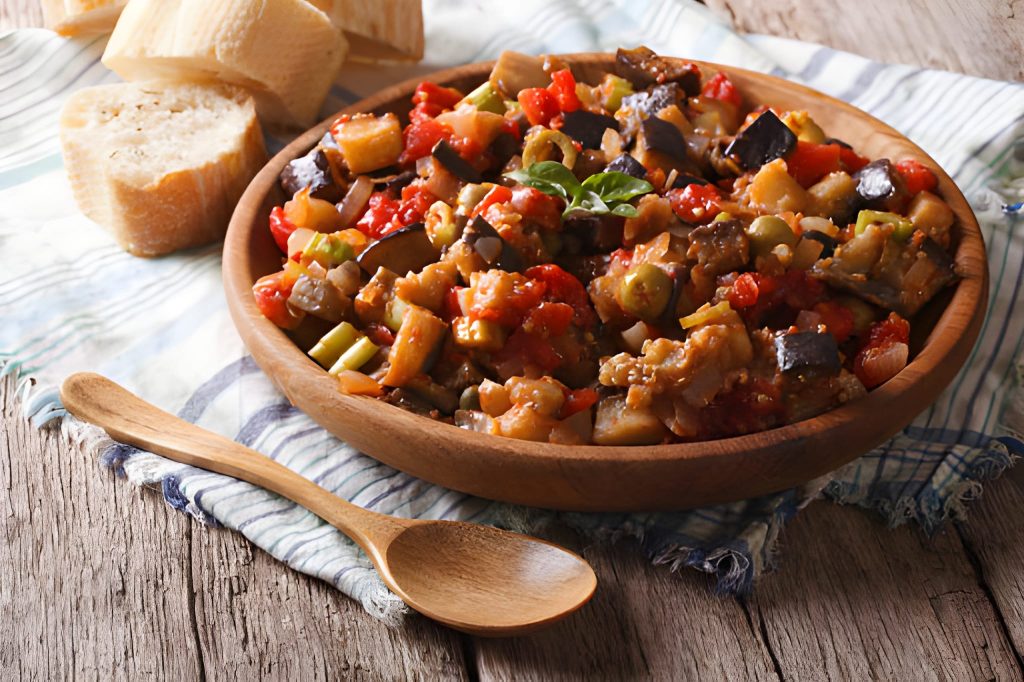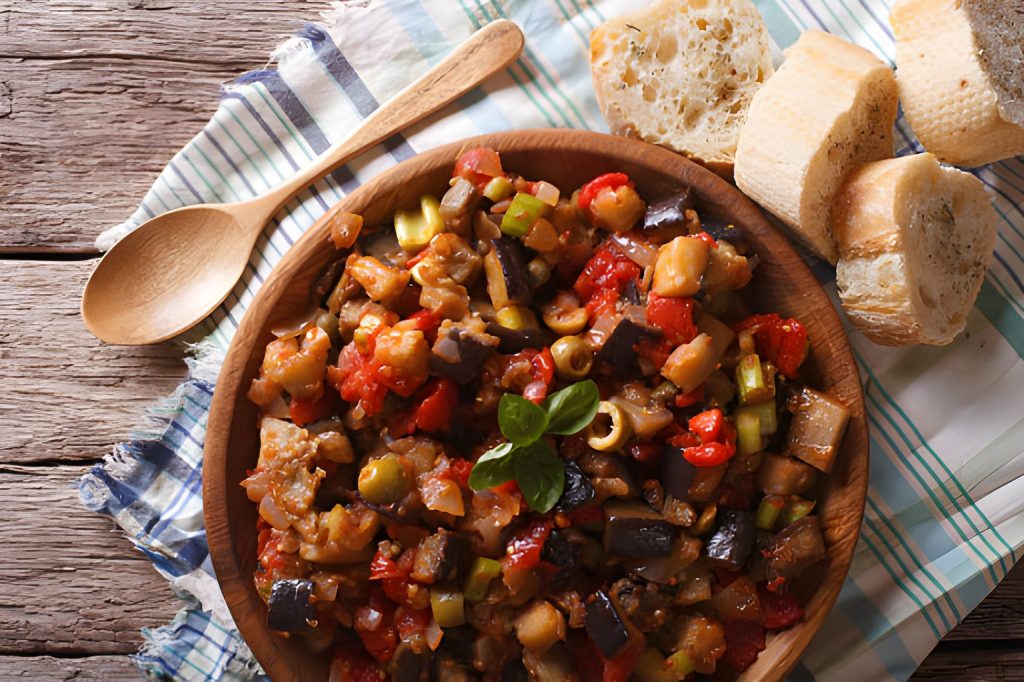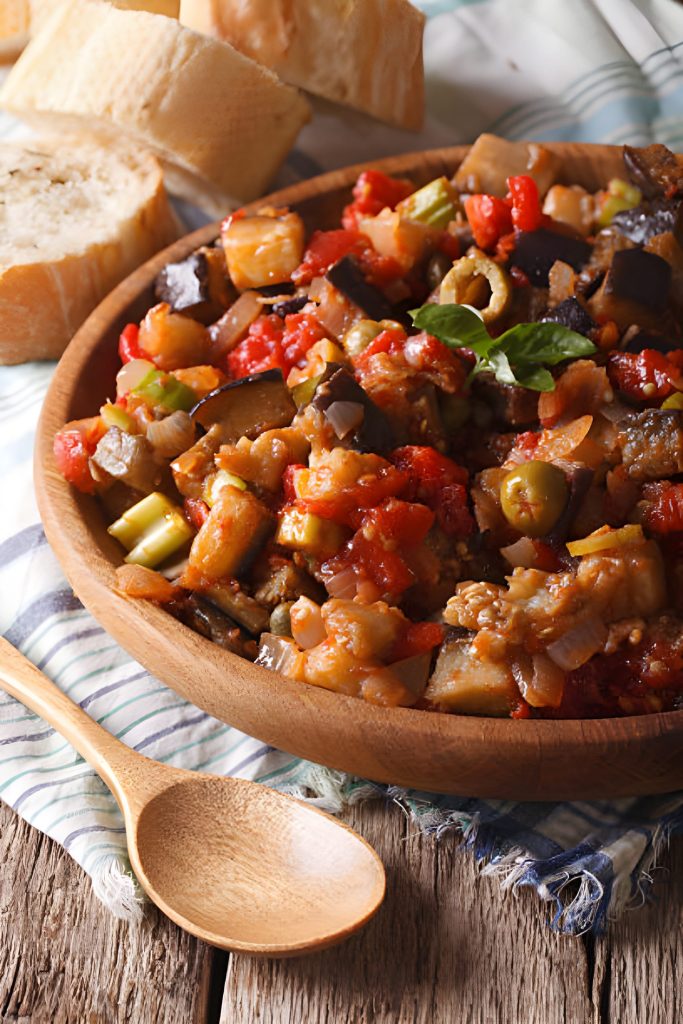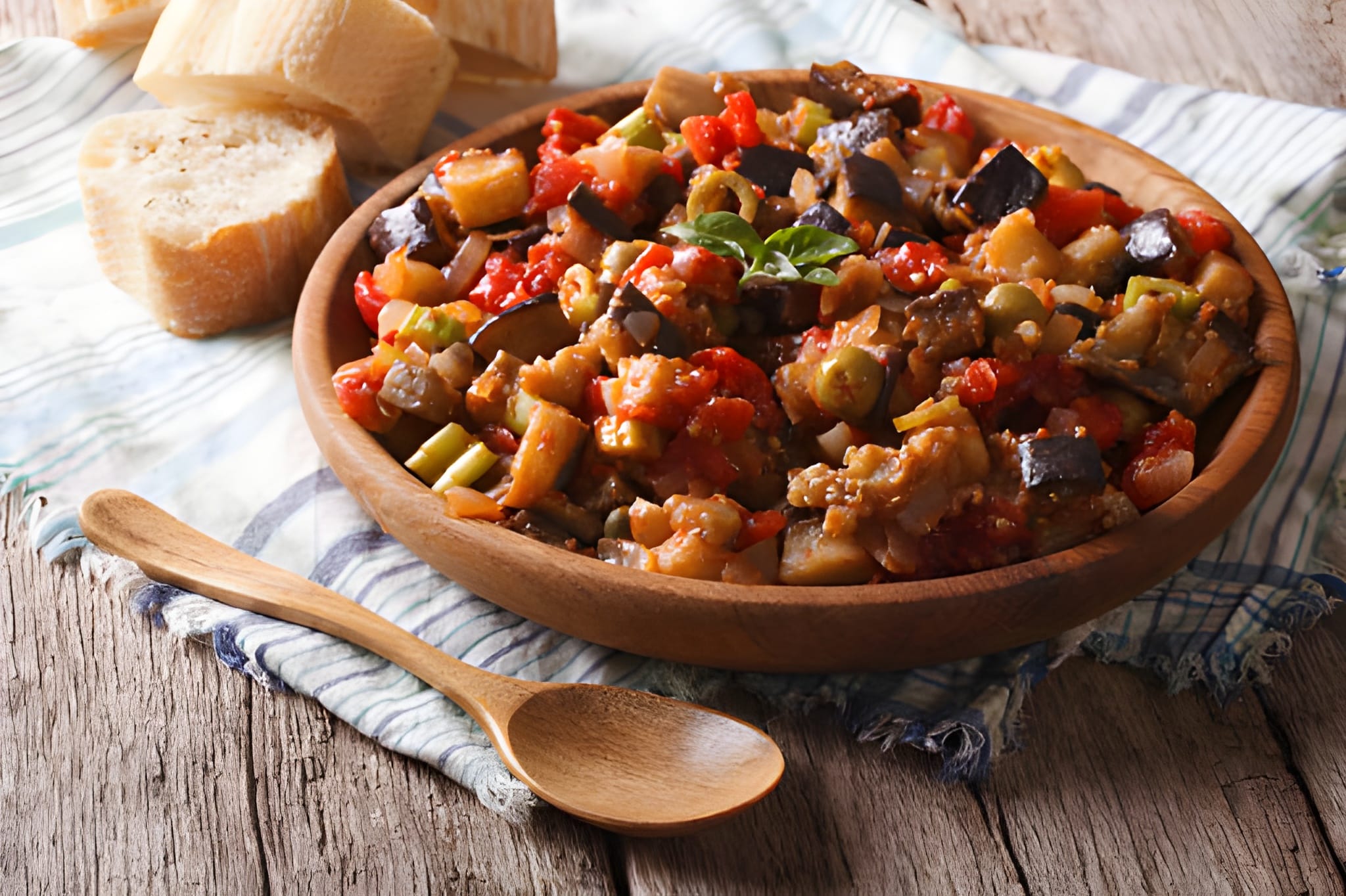Eggplant Caponata Recipe
Bursting with color, texture, and bold Mediterranean character, Eggplant Caponata is the ultimate balance of tangy, sweet, and savory flavors. Each bite offers something new—tender roasted eggplant, bright tomatoes, briny capers, and the subtle sweetness of raisins, all simmered together in a luscious tomato-wine reduction. This Sicilian-inspired dish is as versatile as it is vibrant, perfect served warm with crusty bread, at room temperature as part of a mezze spread, or chilled as a refreshing antipasto.

Ingredient Breakdown
The star of the dish, eggplant, transforms beautifully when salted and roasted. Salting draws out its natural bitterness, while roasting creates a golden exterior and a buttery-soft interior that readily absorbs the bold flavors of the sauce. The result is tender cubes with just the right amount of structure, never soggy or greasy.
The vegetable base—onions, celery, and red bell peppers—adds depth and aroma. These ingredients form a flavorful backbone, softening gently in olive oil until their natural sweetness emerges. Together, they give the caponata its distinctive, savory undertone.
What truly makes this dish sing are the flavor boosters: capers, olives, and raisins. Capers and olives infuse a sharp, salty punch that contrasts beautifully with the plump, sweet raisins. This marriage of flavors captures the essence of Mediterranean cuisine, where sweetness and acidity coexist in perfect harmony.
The liquid components, red wine vinegar and dry white wine, are responsible for the caponata’s tangy brightness. The vinegar sharpens and lightens the dish, while the wine lends an aromatic depth that ties the sauce together. When simmered, they meld with the crushed tomatoes to create a glaze-like consistency that coats every vegetable.
Finally, the finishing touches—fresh parsley, mint, honey, and a touch of crushed red pepper—bring everything into balance. The herbs lift the flavors with freshness, the honey softens the acidity, and the pepper adds gentle heat. Each ingredient plays a role in crafting a dish that’s bold yet refined.
Step-by-Step Preparation Guide
The key to perfect caponata begins with preparing the eggplant properly. After cutting it into cubes, a generous sprinkle of salt helps draw out excess moisture and any bitterness. Allowing it to rest before roasting ensures a creamy texture inside and crisp edges outside. Roasting in olive oil until golden brings out the eggplant’s natural sweetness, setting the stage for the layers of flavor to come.
As the eggplant roasts, the base begins in a skillet with olive oil and aromatic vegetables. The onions, peppers, and celery slowly caramelize, releasing their natural sugars and forming a deeply flavorful foundation. A pinch of salt and pepper enhances this stage, balancing the sweetness of the vegetables.
Once softened, the remaining ingredients—tomatoes, capers, olives, raisins, honey, vinegar, and wine—join the skillet. As the mixture simmers, the liquid reduces and thickens into a glossy sauce. The result is a tangy-sweet glaze that clings to each ingredient, bursting with complexity.
The final combination happens when the roasted eggplant is gently folded into the sauce. A few minutes of simmering allow the eggplant to absorb the rich flavors without losing its texture. Just before serving, parsley and mint are stirred in, adding a fresh, aromatic finish that brightens the entire dish.

Recipe Tips & Frequently Asked Questions
How to achieve the perfect eggplant texture—tender without being oily:
Always salt the eggplant before cooking and roast it instead of frying to prevent it from absorbing excess oil.
Adjusting the balance of sweet, salty, and tangy to match your palate:
Add more honey for sweetness, extra vinegar for acidity, or a handful of olives and capers for added saltiness.
Tips for preventing bitterness in eggplant:
Choose smaller, younger eggplants—they have fewer seeds and milder flavor.
The best olive oil to use for authentic Mediterranean flavor:
Opt for a high-quality extra virgin olive oil with a fruity, peppery finish to complement the richness of the dish.
How to store and serve Caponata for different occasions:
Store in an airtight container for up to five days in the refrigerator. Serve warm as a side, room temperature as a topping for bread, or chilled as part of an antipasto platter.
Can I make Eggplant Caponata ahead of time?
Yes, it tastes even better the next day as the flavors deepen overnight.
How long does it keep in the refrigerator?
Properly stored, it lasts 4–5 days.
Can I freeze it for later use?
Yes, freeze in small portions for up to two months; thaw overnight in the refrigerator before reheating.
What type of vinegar works best if I don’t have red wine vinegar?
Substitute with white wine vinegar or apple cider vinegar for a similar tang.
Is it meant to be served warm or cold?
Traditionally, it’s enjoyed at room temperature or cold, but it’s equally delicious warm.
What to Serve With This Recipe
Eggplant Caponata shines as both a star and a side. Pair it with grilled fish, roasted chicken, or lamb chops for a hearty Mediterranean meal. Its tangy profile also complements creamy dishes like polenta or mashed potatoes, balancing richness with acidity.
Serve it as a topping for toasted baguette slices or crostini for a simple yet elegant appetizer. It’s also a delightful addition to grain bowls, couscous, or quinoa for a vegetarian meal bursting with flavor. For drinks, crisp white wines like Sauvignon Blanc or light reds like Pinot Noir pair beautifully, enhancing the dish’s fruity and acidic notes.
Creative Variations
To add texture and nuttiness, toss in toasted pine nuts or slivered almonds just before serving. For a garden-inspired twist, include zucchini, artichokes, or sun-dried tomatoes for additional depth. Caponata can also transform into a pasta sauce—just toss it with penne or spaghetti and top with a sprinkle of Parmesan. Or use it as a flavorful sandwich filling layered with mozzarella and arugula for a quick Mediterranean-style lunch.
Eggplant Caponata is a dish that captures the heart of Mediterranean cooking—bold yet balanced, rustic yet elegant. With its sweet-and-sour flavor, glossy texture, and aromatic herbs, it brings warmth and sophistication to any table. Whether enjoyed as a side, a spread, or a light meal on its own, this recipe is proof that simple ingredients, when prepared with care, can create something truly unforgettable.

Ingredients
1 large eggplant (about 1¼ lb), cut into 1-inch cubes
1 yellow onion, finely chopped
1 red bell pepper, cored and chopped
2 small celery stalks, thinly sliced
1 cup crushed tomatoes
¼ cup pitted green olives, roughly chopped
2 tbsp capers
¼ cup raisins
2 tbsp chopped fresh parsley
2 tbsp chopped fresh mint
2 teaspoons honey, or to taste
¼ cup red wine vinegar
¼ cup dry white wine
¼ to ½ teaspoon crushed red pepper flakes
1 bay leaf
Kosher salt and freshly ground black pepper
Extra virgin olive oil
Instructions
Preheat the oven to 400°F (200°C). Sprinkle the eggplant cubes generously with salt and, if time permits, set them aside in a colander for 20–30 minutes to draw out excess moisture and bitterness. Once rested, gently pat the cubes dry with a paper towel.
Spread the eggplant pieces on a large baking sheet, drizzle with about 3 tablespoons of extra virgin olive oil, and toss to ensure even coating. Roast in the preheated oven for 25–30 minutes, turning halfway through, until golden and tender.
Meanwhile, heat 2 tablespoons of extra virgin olive oil in a large skillet over medium heat. Add the chopped onion, red bell pepper, and celery. Season lightly with salt and black pepper, then sauté for 5–7 minutes, stirring occasionally, until the vegetables are softened and aromatic.
Add the crushed tomatoes, capers, chopped olives, raisins, honey, bay leaf, and red pepper flakes to the skillet. Pour in the red wine vinegar and white wine, stirring well to combine. Reduce the heat to medium-low and let the mixture simmer gently for about 10 minutes, allowing the flavors to meld and the sauce to thicken slightly.
Fold in the roasted eggplant cubes and cook for an additional 2–3 minutes, letting them soak up the tangy-sweet sauce. Discard the bay leaf, then stir in the fresh parsley and mint just before serving for a burst of brightness.
Serve warm, at room temperature, or chilled as a flavorful side dish or antipasto.

Eggplant Caponata Recipe
Ingredients
- 1 large eggplant about 1¼ lb, cut into 1-inch cubes
- 1 yellow onion finely chopped
- 1 red bell pepper cored and chopped
- 2 small celery stalks thinly sliced
- 1 cup crushed tomatoes
- ¼ cup pitted green olives roughly chopped
- 2 tbsp capers
- ¼ cup raisins
- 2 tbsp chopped fresh parsley
- 2 tbsp chopped fresh mint
- 2 teaspoons honey or to taste
- ¼ cup red wine vinegar
- ¼ cup dry white wine
- ¼ to ½ teaspoon crushed red pepper flakes
- 1 bay leaf
- Kosher salt and freshly ground black pepper
- Extra virgin olive oil
Instructions
- Preheat the oven to 400°F (200°C). Sprinkle the eggplant cubes generously with salt and, if time permits, set them aside in a colander for 20–30 minutes to draw out excess moisture and bitterness. Once rested, gently pat the cubes dry with a paper towel.
- Spread the eggplant pieces on a large baking sheet, drizzle with about 3 tablespoons of extra virgin olive oil, and toss to ensure even coating. Roast in the preheated oven for 25–30 minutes, turning halfway through, until golden and tender.
- Meanwhile, heat 2 tablespoons of extra virgin olive oil in a large skillet over medium heat. Add the chopped onion, red bell pepper, and celery. Season lightly with salt and black pepper, then sauté for 5–7 minutes, stirring occasionally, until the vegetables are softened and aromatic.
- Add the crushed tomatoes, capers, chopped olives, raisins, honey, bay leaf, and red pepper flakes to the skillet. Pour in the red wine vinegar and white wine, stirring well to combine. Reduce the heat to medium-low and let the mixture simmer gently for about 10 minutes, allowing the flavors to meld and the sauce to thicken slightly.
- Fold in the roasted eggplant cubes and cook for an additional 2–3 minutes, letting them soak up the tangy-sweet sauce. Discard the bay leaf, then stir in the fresh parsley and mint just before serving for a burst of brightness.
- Serve warm, at room temperature, or chilled as a flavorful side dish or antipasto.

